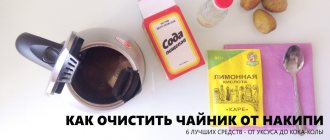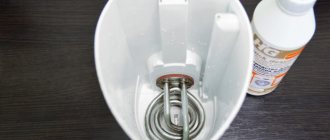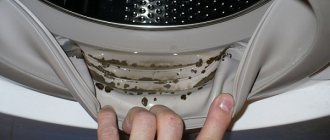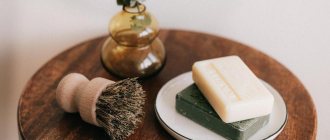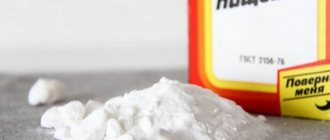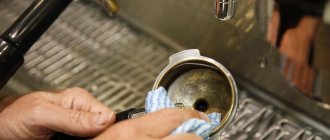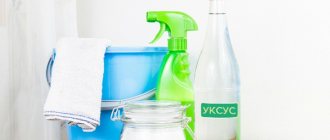Regardless of what material the kettle is made of, over time scale begins to appear on its walls.
This is nothing more than undissolved salts and other trace elements present in large quantities in tap water.
The problem of scale cannot be ignored, because it not only gives boiled water a specific taste, increases the boiling time, but also significantly reduces the service life of the household appliance.
We will tell you in this article how you can descale a kettle with soda.
Is it possible to clean, the pros and cons of the procedure
The cleaning properties of baking soda have been known for a long time. Sodium bicarbonate (also known as sodium bicarbonate or simply soda), dissolving in hot water, destroys limescale, removes unpleasant odors and disinfects the walls of the kettle.
Baking soda is an excellent cleaning agent for glass, enamel, ceramic, and electrical appliances.
Pros of using baking soda to clean your kettle:
- It not only cleans efficiently, but also disinfects the surface.
- Absolutely safe for health, does not emit toxic substances upon contact with hot water.
- Soda diluted with water can be used as a mild abrasive that does not leave scratches on the surface.
Among the negative characteristics, soda is insufficiently effective against old limescale deposits when used in its pure form. In order to enhance the cleaning properties, soda must be mixed with other ingredients (for example, salt or citric acid).
What is scale and how does it affect the human body?
Scale is deposits of lime found in drinking water. It is formed during the boiling process and remains on the walls of the kettle.
These deposits pose a danger to both the condition of equipment and human health:
- provoke overheating of the kettle material;
- cause its breakdown;
- when ingested along with drinking water, they can cause urolithiasis.
Reference. Lime is a dense formation. They cover the heating elements and do not allow them to come into contact with water. As a result, the kettle overheats to too high temperatures, which is one of the common causes of its breakdown.
However, if you wash the kettle in time, this can be avoided.
How often should deposits be removed?
Regular cleaning will help prevent excessive limescale build-up.
The surfaces of a glass teapot need to be cleaned at least once every seven days (tiny particles of limescale are visible on the transparent walls). Monthly cleaning will help keep metal or ceramic teapots clean.
The frequency of cleaning is affected by the quality of the water used . By pouring bottled or well-filtered water into dishes, you can reduce the number of cleanings to a minimum.
General recommendations
You can prevent the appearance of plaque if you properly care for the device. Necessary:
- First filter the liquid, and only then pour it into the kettle. Hard water destroys the coating and leads to scale formation.
- Wash the product daily. In this case, the water should be warm and the sponge soft. It is also important that the detergent lathers well.
- Clean every 2 weeks. This will extend the life of the kettle.
- Pour the cooled water from the kettle into another container. This way you can clean several containers at once.
Soda is harmless to take orally. However, it may cause skin irritation. To avoid this, you should wear gloves.
Subscribe to TechnoCouncil on social networks so you don’t miss anything:
Features depending on material
When choosing a descaling method, it is important to consider the material the kettle is made of.
Enameled surface
It is not recommended to clean enamel coatings with citric acid alone or in combination with vinegar.
The thing is that acid thins the enamel coating , which leads to the very rapid appearance of pockets of rust and corrosion.
In addition, enamel surfaces are easily scratched by loose powders and other abrasive cleaning compounds.
The most suitable means of removing limescale from an enamel surface are:
- sparkling water,
- special cleaning tablets,
- peeling potatoes or apples.
To prevent the enamel kettle from changing color during cleaning with carbonated water, you must use only colorless drinks (for example, mineral water).
Electric
Particular care should be taken when using citric acid . It's simple: an aggressive environment destroys rubber seals, thereby reducing the service life of a household appliance.
The best choice of cleaning agent for an electric kettle is lemon water, baking soda and salt.
Stainless steel
Citric acid and carbonated drinks will help you quickly clean a stainless steel kettle from limescale (it is not necessary to choose soda without dyes).
Particular care should be taken when choosing abrasive detergents . Small particles perfectly remove limescale, but unfortunately they leave scratches on the gloss of stainless steel, which are impossible to get rid of.
Ceramics
The main rule for cleaning ceramic dishes is that all actions must be extremely careful. Ceramics cannot withstand impacts, strong friction, or sudden temperature changes.
The optimal choice of cleaning method for a ceramic teapot is to use citric acid, soda and household chemicals.
Glass
You can maintain the original appearance of a glass teapot only with regular cleaning. Vinegar water or special chemicals will help remove limescale .
It is worth avoiding abrasive powders, as they leave scratches on the glass surface.
Why soda
The fact that soda is added to the dough as a leavening agent, it perfectly cleanses joints and helps with heartburn, is known even to the not-so-ideal housewife. Meanwhile, there are other useful uses of baking soda in the kitchen.
Sodium bicarbonate has a soft, crystalline molecular structure, making it suitable for corrosion control as well as surface cleaning. Crystals dissolve well in water without damaging the surface being cleaned, so it can be used to clean glass, metal and other sensitive materials from which kitchen appliances are made.
In addition, soda is completely harmless, biologically organic and decomposes at temperatures above 60 degrees Celsius, so it does not pose any threat to the environment. Unlike commonly used household cleaning detergents and bleaches, baking soda is not harmful to the human body because it does not cause burns or toxic fumes.
Alternative means to remove plaque
It's easy to descale your kettle. There are a huge number of folk remedies and special chemicals that help to clean quickly and efficiently.
Top 3 most popular folk remedies:
Sweet carbonated drinks .
The composition of the soda contains citric acid, which corrodes any, even very dense layer of limescale. The kettle is filled with sweet carbonated water and brought to a boil. After the boiled soda has cooled, leave the dishes alone for thirty minutes. The last stage is to rinse the already cleaned surfaces thoroughly with cold running water.- Apple and potato peelings . The container is filled with vegetable and fruit peelings, then filled with water and placed on the fire to boil. After the cleaning has been boiled for five to ten minutes, the kettle is turned off and left alone for at least three hours. This time is enough for the scale to become soft and can be cleaned off with a sponge.
- Aspirin tablets . It is enough to dissolve four aspirin tablets in 2 liters. water, pour the resulting liquid into the kettle. The solution with aspirin is boiled for at least thirty minutes, after which the walls are easily cleaned with a soft sponge.
Top 3 special anti-scale cleaners:
- Top House Cleaner . A liquid consisting of 5% organic acid will carefully and quickly clean limescale deposits from the inner surface of a kettle and coffee machine. The liquid is odorless and does not cause allergic reactions upon contact with skin. Manufacturer Germany. The average cost is 260 rubles. (500 ml bottle).
- Topperr 3031 , a concentrated product from a German manufacturer, will clean surfaces of limescale the first time. Topperr 3031 will protect the walls of the kettle and coffee maker from the rapid formation of plaque. The cost of the concentrate is 140 rubles. (250 ml bottle).
- SANO Antikalk Kettle Descaler gel is effective for cleaning ceramic, glass, and plastic kettles. Developed on the basis of phosphoric and sulfamic acid. Economical consumption and low cost make SANO Antikalk Kettle Descaler gel very popular among consumers. The average cost is 350 rubles. (700 ml bottle).
Removing large layers of scale
All kettles, except electric kettles, are cleaned of old scale with a mixture of vinegar, soda and citric acid. Complex processing in several stages will be required.
In a kettle, dilute water with a tablespoon of soda and boil. Pour out the contents. Fill with water adding 1 tbsp. citric acid. Boil and keep at low simmer for half an hour. In the third stage, pour water into an empty kettle and 1/2 cup of vinegar. After boiling, simmer for another half hour. Drain the solution. After the procedure, plaque may remain on the walls, but it has already softened and can be removed with a sponge. To rinse the kettle, bring clean water to a boil and remove. Repeat several times.
Soda and acetic acid. The product is effective for thick plaque. But it cannot be used for an electric kettle. Take 2 tbsp. l. soda and 2 liters of water. Let the ingredients simmer for half an hour. Drain and fill clean, adding 1 tbsp. vinegar, boil for 30 minutes. The scale deposits will become soft and easy to clean with a sponge, after which you must rinse with water.
Adviсe
To make the descaling process quick and effective, experts recommend using some tips:
The most effective cleaning products contain acid (citric acetic acid, fruit acid).- If the scale cannot be cleared the first time, it must be carefully rubbed with a scraper, and then the cleaning must be repeated.
- After the limescale has been removed, the kettle is filled with clean water and boiled again. These simple steps will help remove any remaining cleaning products.
Experienced housewives also recommend using only filtered water for boiling. In this case, the scale problem will occur much less frequently.
Can these cleaning products be used at home?
The sediment that appears as a result of boiling water is difficult to remove by simply washing the kettle. This is due to the fact that lime deposits are insoluble in water.
Even purchased purified water, like water that has passed through home filters, has a low level of mineralization and can also form sediment during the heating process.
Vinegar is an acid that reacts with sediment substances and destroys them. Soda is an alkali that helps loosen scale. With the simultaneous use of acid and alkali, the effect is enhanced and the plaque is destroyed.
Table vinegar and baking soda are food products that can be used to treat the inside surface of a kettle.
Rules for cleaning the kettle
Even in the most advanced situations, it is not recommended to remove scale with metal brushes and sponges, or to mechanically chip off plaque from the kettle with objects such as knives or forks. Such harsh methods can seriously damage the equipment, after which repairs will be required.
Choose the most effective methods among gentle ones, for example, such as cleaning the kettle with citric acid, soda solution or household chemicals. Always use a soft sponge afterwards: a good cleaning will get rid of plaque residue on the bottom and in hard-to-reach places.
The list of rules ends with thorough rinsing followed by boiling clean water. Do not neglect the latest recommendations - this will protect the body from chemicals, aggressive acids or alkalis.
Method number 2: Lemons
At home, you can clean the kettle with real lemons.
The instructions for “general” cleaning for the inner surface of the heating device will be as follows:
- Cut the lemon into 6-7 parts.
- Place the pieces of fruit in the teapot.
- Fill them with warm water, from the tap.
- Place the container on the fire or plug it in.
- Boil the lemon for 10-15 minutes on the stove or boil the acidic water in an electric appliance 2-3 times after it has cooled.
- Rinse the dishes.
The benefits of cleaning the kettle with lemon slices are::
- Naturalness of the product. It is impossible to get poisoned by fruit acid, even if you do not wash the device well after cleaning.
- Availability. You can buy lemons in the store closest to your home, at any time of the year.
- It washes off the first time. It takes a long time to get rid of the remnants of the product; there is no need to smell it. You can use the kettle immediately after cleaning.
There are also minor disadvantages:
- Lemon juice is ineffective against old scale. It is better to remove thick layers of plaque using granulated lemon juice.
- Expensive. If you compare the price of packaged citric acid and the cost of natural fruit, it is cheaper to use a granular product.
Experienced fighters against scale in a kettle using improvised means share a secret: when the device with citric acid is on the stove, you need to make the fire strong until the first gurgles of water. Next, reduce the heat to low and boil the liquid for 15 minutes.
In this case, the effect of lemongrass will increase, and you definitely won’t have to repeat the procedure.
